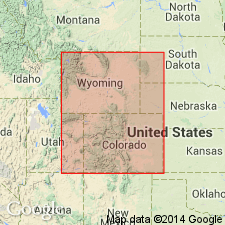
- Usage in publication:
-
- Harding sandstone*
- Modifications:
-
- Original reference
- Dominant lithology:
-
- Sandstone
- Shale
- AAPG geologic province:
-
- Denver basin
Summary:
Pg. 154-167. Harding sandstone. The lower bed is a shore-line deposit following the advance of the sea upon the land; it is formed of coarse grains of quartz and small quartz pebbles imbedded in a fine arenaceous matrix, and is 5 feet thick. The succeeding layers of sandstone have more or less calcareous matter in the matrix; their fossils all prove the littoral origin of the sediments. The closing deposit of the sandstone series is coarse drifted sand, containing numerous fragments of larger fish plates than those below. The change to succeeding shaly beds at top is abrupt, and apparently due to deepening of the water and cessation of arenaceous deposits. The shaly beds are 2 to 4 feet thick, and consist of red and purple fine-grained argillaceo-arenaceous shale. Thickness of formation at Harding's sandstone quarry, about 1 mile northwest of State Penitentiary, Canyon City, 86 feet. Rests unconformably on Algonkian bedded gneiss and micaceous schists. Overlain by Fremont limestone.
Named from exposures in Harding's quarry, about 1 mi northwest of the State Penitentiary at Canyon City [Canon City], Fremont Co., CO. [Quarry now (ca. 1966) one of several pits operated under name of Bernite Gannister Quarries.]
[GNC remark (ca. 1938, US geologic names lexicon, USGS Bull. 896, p. 909): Now considered by [Edwin] Kirk to be of approximate late Black River or early Trenton age. Age is considered Middle Ordovician.]
Source: US geologic names lexicons (USGS Bull. 896, p. 909; USGS Bull. 1200, p. 1247, 1671-1672); supplemental information from GNU records (USGS DDS-6; Denver GNULEX).
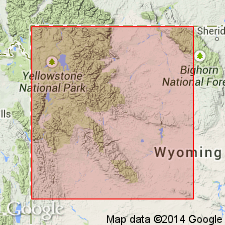
- Usage in publication:
-
- Harding sandstone*
- Modifications:
-
- Overview
- AAPG geologic province:
-
- Denver basin
Summary:
Occurs near Colorado Springs, Canyon City, and Perry park, El Paso Co, CO in the Denver basin. Correlated with the basal sandstone of the Bighorn limestone of the Bighorn Mountains of WY. Contains fossils (listed) of Trenton age. Fish remains found in Harding quarry near Canon City resemble those found in the basal sandstone of the Bighorn. Of Ordovician age.
Source: GNU records (USGS DDS-6; Denver GNULEX).
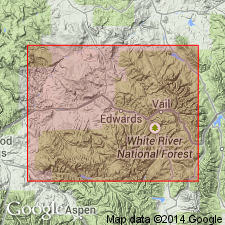
- Usage in publication:
-
- Harding quartzite*
- Modifications:
-
- Areal extent
- AAPG geologic province:
-
- Eagle basin
Summary:
Pg. 152 (table 1), 166-169. Harding quartzite. Tan, white, and greenish quartzite and some greenish sandstone. In Pando area, unconformably overlies Peerless formation and unconformably underlies Parting quartzite member of Chaffee formation. [Age is Middle Ordovician.]
Source: US geologic names lexicon (USGS Bull. 1200, p. 1671-1672).
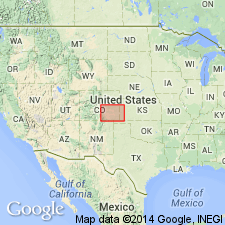
- Usage in publication:
-
- Harding sandstone*
- Modifications:
-
- Areal extent
- AAPG geologic province:
-
- Las Vegas-Raton basin
- Denver basin
Summary:
Exposed continuously from Deadmans Canyon to Canyon City in Pueblo, El Paso, and Fremont Cos, CO of the Denver basin and Custer Co, CO of the Las Vegas-Raton basin. Ranges from 68 ft thick at Deadman Canyon to 151 ft in Priest Canyon. Composed of: lower white subround coarse-grained to pink and white, very fine grained limy sandstone, with quartz pebbles at base; middle and upper sandstones. Disconformably overlies the stratigraphically restricted Manitou limestone; is unconformably overlain by Fremont limestone. Correlated with Simpson group, even though Simpson known only in easternmost Baca Co. Of Middle Ordovician age. Cross sections.
Source: GNU records (USGS DDS-6; Denver GNULEX).
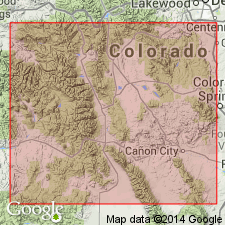
- Usage in publication:
-
- Harding formation
- Modifications:
-
- Areal extent
- AAPG geologic province:
-
- Denver basin
- Las Vegas-Raton basin
- San Luis basin
- Eagle basin
- Piceance basin
- South Park basin
Summary:
Is a Late Ordovician formation that is coextensive with the overlying Fremont formation. Is present in CO (distribution and isopach maps) in Fremont, Teller, El Paso, and Pueblo Cos in the Denver basin; Custer Co in the Las Vegas-Raton basin; Saguache Co in the San Luis basin, Gunnison Co in the Piceance basin; Chaffee, Lake, Pitkin, and Eagle Cos in the Eagle basin; and Park Co in the South Park basin. Section 120.5 ft thick measured at abandoned pit at Harding quarry, S1/2 N1/4 sec 31, T18S, R70W, Fremont Co [compare with section 75 ft thick described by Walcott (1892)] where it overlies Idaho Springs formation and underlies Fremont formation. Section in this report has a basal white, massive conglomerate of subangular to subround quartz pebbles in a quartz matrix 4.7 ft thick overlain by white to maroon sandstone that varies from thin to thick to massive bedded, and fine to medium grained. In upper part of measured section, one red-brown argillaceous siltstone and two maroon to green shale beds present. Formation is divided along Front Range and in Wet Mountains into a lower thin-bedded sandstone, middle shale, and an upper thin-bedded to massive sandstone. West of Front Range, these members cannot be recognized. Cross sections. Fossils (Porifera, brachiopods, gastropods, pelecypods, cephalopods, trilobites, fish plates, conodonts) found in Harding are listed. Regional variations and correlations described. Of Late Ordovician (Black River) age.
Source: GNU records (USGS DDS-6; Denver GNULEX).
For more information, please contact Nancy Stamm, Geologic Names Committee Secretary.
Asterisk (*) indicates published by U.S. Geological Survey authors.
"No current usage" (†) implies that a name has been abandoned or has fallen into disuse. Former usage and, if known, replacement name given in parentheses ( ).
Slash (/) indicates name conflicts with nomenclatural guidelines (CSN, 1933; ACSN, 1961, 1970; NACSN, 1983, 2005, 2021). May be explained within brackets ([ ]).

